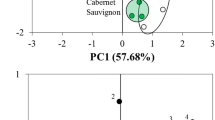Abstract
Moscatel wines from Setúbal were analyzed for their total phenolic (mean value 1,243 mg gallic acid equivalents/L), and total flavonoid (mean value 248 mg catechin/L) composition by spectrophotometric and chromatographic methods were used to quantify phenolic compounds as benzoic acids, cinnamic acids, stilbens, and some flavonoids. Antioxidant activity of the wines was evaluated by 1,1-diphenyl-2-picrylhydrazyl (DPPH; mean value 70.7% inhibition), ferric reducing antioxidant power (FRAP; mean value 3,098 mg of Trolox equivalents/L) and oxygen radical absorbance capacity (ORAC; mean value 10,724 μmol/L) assays. Results were analyzed using principal component analysis which allowed samples to be grouped in terms of both winemaking producer and vintage. By plotting correlation loadings, it was possible to understand which variables were responsible for sample distribution. The correlation between results obtained for variables show that, in general, total flavonoid content is a better estimation of antioxidant activity in Moscatel samples (r ORAC/flavonoids = 0.832, r FRAP/flavonoids = 0.677) than total phenolic content (r ORAC/phenolics = 0.680, r FRAP/phenolics = 0.372). No major correlations were detected for DPPH assay results (r DPPH/flavonoids = 0.283, r DPPH/phenolics = 0.271). Chromatographic profiles showed important differences among Moscatel wines. Gallic acid contents and results of antioxidant activity tests were strongly correlated (r values in the range 0.74–0.92). Correlations of the results obtained for antioxidant activity tests with contents of other phenolic compounds such as ethyl caffeate, ethyl gallate, caffeic acid, protocatechuic acid, and t-caftaric acid depend on sample and type of test employed.




Similar content being viewed by others
References
Alonso AM, Castro R, Rodríguez MC, Guillén DA, Barroso CG (2004) Food Res Int 37:715, doi:10.1016/j.foodres.2004.03.007
Arvanitoyannis IS, Katsota MN, Psarra EP, Soufleros EH, Kallithraka S (1999) Trends Food Sci Technol 10:321, doi:10.1016/S0924-2244(99)00053-9
Balasundram N, Sundram K, Samman S (2006) Food Chem 99:191, doi:10.1016/j.foodchem.2005.07.042
Biglari F, AlKarkhi AFM, Easa AM (2008) Food Chem 107:1636, doi:10.1016/j.foodchem.2007.10.033
Borbalán AMA, Zorro L, Guillén DA, Barroso CG (2003) J Chromatogr A 1012:31, doi:10.1016/S0021-9673(03)01187-7
Bravo MN, Silva S, Coelho AV, Vilas Boas L, Bronze MR (2006) Anal Chim Acta 563:84, doi:10.1016/j.aca.2005.11.054
Bravo MN, Feliciano R, Silva S, Coelho AV, Vilas Boas L, Bronze MR (2008) J Food Compos Anal 21:634–643, doi:10.1016/j.jfca.2008.04.007
Deng D, Zhang J, Cooney JM, Skinner MA, Adaim A, Jensen DJ, Stevenson DE (2006) FEBS Lett 580:5247, doi:10.1016/j.febslet.2006.08.051
Di Majo D, La Guardia M, Giammanco S, La Neve L, Giammanco M (2008) Food Chem 111:45, doi:10.1016/j.foodchem.2008.03.037
Fernández-Pachón MS, Villaño D, Troncoso AM, García-Parrilla MC (2006) Anal Chim Acta 563:101, doi:10.1016/j.aca.2005.09.057
Huang D, Ou B, Hampsch-Woodill M, Flanagan JA, Prior RL (2002) J Agric Food Chem 50:4437, doi:10.1021/jf0201529
Kallithraka S, Arvanitoyannis IS, Kefalas P, El-Zajouli A, Soufleros E, Psarra E (2001a) Food Chem 73:501, doi:10.1016/S0308-8146(00)00327-7
Kallithraka S, Arvanitoyannis I, El-Zajouli A, Kefalas P (2001b) Food Chem 75:355, doi:10.1016/S0308-8146(01)00213-8
Katalinić V, Milos M, Modun D, Musić I, Boban M (2004) Food Chem 86:593, doi:10.1016/j.foodchem.2003.10.007
Katalinic V, Milos M, Kulisic T, Jukic M (2006) Food Chem 94:550, doi:10.1016/j.foodchem.2004.12.004
Kaur C, Kapoor HC (2001) Int J Food Sci Technol 36:703, doi:10.1046/j.1365-2621.2001.00513.x
Lugasi A, Hóvári J (2003) Nahrung 2:79, doi:10.1002/food.200390031
Maksimović Z, Malenčić D, Kovačević N (2005) Bioresour Technol 96:873, doi:10.1016/j.biortech.2004.09.006
Monagas M, Bartolomé B, Mez-Cordovés C (2005) Crit Rev Food Sci Nutr 45(2):85, doi:10.1080/10408690490911710
Moreno-Arribas MV, Polo MC (2005) Crit Rev Food Sci Nutr 45(4):265, doi:10.1080/10408690490478118
Nenadis N, Lazaridou O, Tsimidou MZ (2007) J Agric Food Chem 55:5452, doi:10.1021/jf070473q
Paixão N, Perestrelo R, Marques JS, Câmara JS (2007) Food Chem 105:204, doi:10.1016/j.foodchem.2007.04.017
Pérez-Jiménez J, Arranz S, Tabernero M, Díaz-Rubio ME, Serrano J, Goñi I, Saura-Calixto F (2008) Food Res Int 41:274, doi:10.1016/j.foodres.2007.12.004
Pérez-Magarino S, González-San José ML (2006) Food Chem 96(2):197
Ren W, Qiao Z, Wang H, Zhu L, Zhang L (2003) Med Res Rev 23(4):519
Rivero-Pérez MD, Muñiz P, González-San José ML (2007) J Agric Food Chem 55:5476, doi:10.1021/jf070306q
Robards K, Prenzler PD, Tucker G, Swatsitang P, Glover W (1999) Food Chem 66:401, doi:10.1016/S0308-8146(99)00093-X
Rosginsky V, Lissi EA (2005) Food Chem 92:235, doi:10.1016/j.foodchem.2004.08.004
Sarni-Machado P, Cheynier V, Moutounet M (1999) J Agric Food Chem 47:42, doi:10.1021/jf9805146
Shaghaghi M, Manzoori JL, Jouyban A (2008) Food Chem 108:695, doi:10.1016/j.foodchem.2007.11.008
Soleas GJ, Diamandis EP, Goldberg DM (1997) J Clin Lab Anal 11:287–313, doi:10.1002/(SICI)1098-2825(1997)11:5<287::AID-JCLA6>3.0.CO;2-4
Staško A, Brezová V, Mazúr M, Čertík M, Kaliňák M, Gesheidt G (2008) LWT-Food Sci Technol 41:2126–2135, doi:10.1016/j.lwt.2007.11.021
Szöllösi R, Varga IS (2002) Act Biol Szeg 46:125
Villaño D, Fernández-Pachón MS, Trancoso AM, Garcia- Parrilla MC (2004) Talanta 62(2):501
Vinson JA, Proch K, Bose P (2001) Methods Enzymol 335:103, doi:10.1016/S0076-6879(01)35235-7
Wang H, Cao GH, Prior RL (1996) J Agric Food Chem 44(3):701, doi:10.1021/jf950579y
Zhishen J, Mengcheng T, Jianming W (1999) Food Chem 64:555, doi:10.1016/S0308-8146(98)00102-2
Acknowledgements
The authors would like to thank the Comissão Vitivinícola Regional da Península de Setúbal for providing Moscatel wines. We are grateful to Camo Software for providing a free-trial software sample and to Jayne Storkson for reading the manuscript.
Author information
Authors and Affiliations
Corresponding author
Rights and permissions
About this article
Cite this article
Feliciano, R.P., Bravo, M.N., Pires, M.M. et al. Phenolic Content and Antioxidant Activity of Moscatel Dessert Wines from the Setúbal Region in Portugal. Food Anal. Methods 2, 149–161 (2009). https://doi.org/10.1007/s12161-008-9059-7
Received:
Accepted:
Published:
Issue Date:
DOI: https://doi.org/10.1007/s12161-008-9059-7




